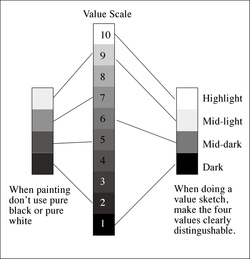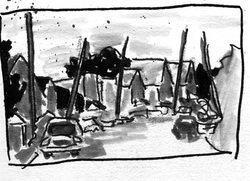 Ask any professional painter and they will tell you that they don't paint objects, scenes or figures, they paint shapes. And to them, shapes are made up of areas of similar value. That is, how dark or light it is. In other words, what makes one shape separate from another shape is its value. There are several value scales going the rounds. Scale of one to ten with ten being white, zero to ten with ten being white. one to ten with ten being black, etc. We're using the one to ten scale with one being black and ten being white. It seems to have won out over the other scales. It's important to know which scale someone is using if they are referring to values, as you can imagine the results of a value of seven will be vastly different depending upon the scale used. You should almost never paint anything either a ten or a one. These things rarely ever occur in nature, although you might use a ten if you were depicting the tiny glint of pure light reflecting off a white or bright metal or glass object. Tiny! Black should next to never be used. In real life, there is no shadow or substance that is pure black. Using pure black is like having a hole in your painting. No light escapes. It's dull. So that leaves values two to nine. Eight values is still too many to easily separate in a scene, and if you do separate a scene into eight values, you will no longer have major shapes. Instead, you will have dozens of little, unconnected shapes, robbing your painting of strength. When you look at a scene, think along the terms of four values, five at most.  Here I've created a "Value Sketch" to help me divide the scene into the four values. While above I said no black and no white, for the purpose of your value sketch, black stands for the darkest values, white for the lightest. They don't stand for black & white. By dividing the scene into these four values, it's so much easier to see the compositional structure. If you cannot make the scene work in this simplified arena, no amount of "fixing" it as you paint will ever make it work as a painting.. The value sketch and the resulting knowledge of where the darks, mid-tones and lights should be, helps you stay honest to the scene as you paint. If it was dark in the sketch, make sure the value is dark in the painting, no matter what the colour. Keith Thirgood www.wilsonstreetstudios.com
1 Comment
We hear this question from our students, fellow artists and each other all the time. Since we've been teaching, and during our own growth as painters, we've found that the answer to this fits into one or more of five general reasons.
Whether you're working from nature, a still life or from a photograph, you need to observe carefully. Good observation requires time and contemplation. Many artists arrive at a location, take a quick look, set up their easels and begin to dive into their painting. Walk around your subject, or if a photo, use cropping "ells" to explore different crops. Get to know your subject. Figure out what draws you to it. Look at the colours in isolation. Determine how the scene is constructed. Make sketches. Once you know what you're painting, observation doesn't stop. For every 30 seconds you spend applying paint to your surface, spend 60 to 90 seconds observing your subject. Next time I'll deal with composition. I've been on the hunt for juried art shows and juried Art in the Park style events. I've spent so much time on it, I've neglected our blog. So I decided to post what I've found in our blog. I invite you to add shows that you've heard of, where there is still time for members to sign up for.
With some of these shows, you have to join the organization hosting them, however, that's often not a real barrier. Sometimes the shows have a restricted geographic barrier. If there are any restrictions that you know of, please mention them when you list a show. If I come across any more, I'll add them to the post. artcetera 2013 Elora Centre for the Arts (ECFTA) http://www.eloracentreforthearts.ca APPLICATION DUE MARCH 8 Beaux Arts Brampton juried show http://beaux-artsbrampton.com APPLICATION DUE MARCH 8 Stratford Art in the Park http://www.artintheparkstratford.com/applicants.php APPLICATION DUE March 15 Sunnyside Beach juried art show (art in the park style)http://www.artinitiatives.ca/sunnyside/home.html APPLICATION DUE MARCH 31 Judith and Norman Alex Art Gallery https://www.jnaag.ca/about/call-for-entry-juried-art-show Application due April 4 (South west Ontario residents only) Aurora Annual Art Show & Sale http://www.town.aurora.on.ca/aurora/artshow April 15 however, once all spots are taken no more are accepted. Blue Mountain Foundation for the Arts http://www.bmfa.on.ca/applications.html APPLICATION DUE April 5 or 6 Quinte Art Council Expressions http://www.quinteartscouncil.org/events/expressions/expressions.html Due April 8 Warkworth Art in the Park http://www.warkworthartinthepark.ca/call-for-entries/ APPLICATION DUE April 12 Jazz It Up juried art show Whitby Jazz it Up APPLICATION DUE April 15 or 17 in person Art in the Park Oakville http://www.artintheparkoakville.com/apply_to_aip.html APPLICATION DUE APRIL 25 Art in the Park Petrolia http://www.artintheparkpetrolia.com/htm/vendor_app.php ASAP Schomberg Village Street Gallery http://svsg.ca/ APPLICATION DUE May 13Art in the Park Sarnia http://artintheparksarnia.com/?q=application/application-fees June 1 or as soon as all space is filled Art in the County held in Picton, Ontario http://artinthecounty.com/ APPLICATION DUE June 14 Uxbridge Art in the Park http://www.uxbridge.com/lionsart/ APPLICATION DUE August 1, however as soon as they have enough artists, they close applications I welcome you to add to this list. Cheers, Keith Thirgood President OPAS www.wilsonstreetstudios.com |
Keith ThirgoodIs an artist working in the Canadian, post impressionist style. I paint en plein air when I can and in the studio the rest of the time. Archives
June 2019
Categories
All
|
 RSS Feed
RSS Feed
